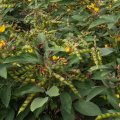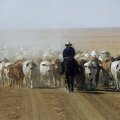University of Queensland researchers trying to pinpoint the mystery killer behind ‘pasture dieback’ find their research is fascinating – but they would much prefer to watch grass grow.
Dieback, which causes large tracts of pasture to unexpectedly collapse and die, has been identified at two sites at UQ’s Gatton campus.
UQ School of Agriculture and Food Sciences lecturer Dr Anthony Young said pasture dieback had been affecting Queensland graziers since the early 1990s and was poorly understood.
“Pastures die over a course of several weeks and render the land unproductive, and we simply don’t know why,” he said.
“Despite affecting an estimated 34,000 hectares of farmland throughout Queensland, there are no known treatments.”
Confirmed cases have shown that pasture dieback destroys valuable grasses – including American buffel grass, creeping blue grass, Rhodes grass and Mitchell grass – but broadleaf weed species are immune.
UQ pasture agronomist Dr Shane Campbell said a multi-disciplinary approach was needed to find a cause and, hopefully, a solution.
“Our research is aiming to eliminate possible causes, such as nutrient imbalances and general drought conditions,” he said.
“We’ve taken samples from various sites and are subjecting them to traditional microbiological methods, as well as molecular techniques, to determine if any known pathogens are associated with the samples.
“We’re also undertaking epidemiological studies, where we attempt to transmit the disorder to otherwise healthy grasses.”
The research has also used satellite imagery to identify signature patterns, determining the rate of spread and correlation with climatic data.
Dr Young and his team hope to uncover a solution that can be applied to all affected agriculture.
“Finding a mystery killer is fascinating, but I’d much prefer to watch grass grow,” he said.
“It’s a big problem, and we’re just one of a number of groups and organisations trying to find what’s behind pasture dieback.
“Hopefully, with such a concerted effort, major breakthroughs will occur in the near future.
“Our goal is to establish an outcome that is economically viable, environmentally sustainable, and resilient against the emergence of new kinds of pasture dieback.”
Research efforts to tackle pasture dieback are being coordinated by Meat and Livestock Australia and the Queensland Government’s Department of Agriculture and Fisheries.
Media: Dr Anthony Young, anthony.young@uq.edu.au, +61 499 292 390; Dominic Jarvis, dominic.jarvis@uq.edu.au, +61 413 334 924.
.jpg)









